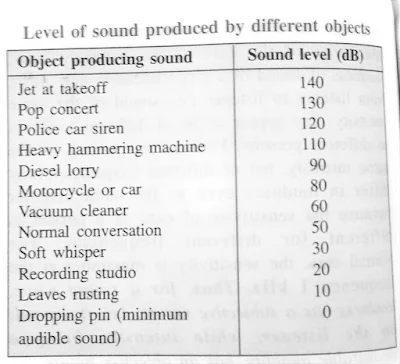Characteristics Of Sound
Two sounds can be distinguished from one another by the following three different characteristics :
(1) loudness, (2) pitch (or shrillness), and (3) quality (or timbre).
The above characteristics of a given sound can be studied from the wave pattern of that sound. Fig. 7.17 shows a set-up to obtain the wave pattern of a sound wave, using a microphone and a cathode ray oscilloscope (C.R.O.). The sound to be studied is produced before the microphone is connected to the Y-input of C.R.O. The wave pattern of sound (i.e., displacement-time graph) is obtained on the screen of C.R.O.
Loudness: Loudness is the characteristic by virtue of which a loud sound can be distinguished from a faint one, both having the same pitch and quality.
The loudness of sound depends on the amplitude of the wave.
Intensity: The intensity of a sound wave at a point of the medium is the amount of sound energy passing per second normally through a unit area at that point. Its unit is watt per metre2 (W m2). The intensity of ordinary sound is nearly 10-6 W m-2, while the minimum intensity of sound audible to our ears is 10-12 W m-2. The greater the energy carried by a sound wave, the greater is the intensity of sound. The intensity of a sound wave in air is proportional to (a) the square of the amplitude of vibrations, (b) the square of the frequency of vibrations, (c) the density of air, and (d) the velocity of sound in air.
Subjective nature of loudness and objective nature of intensity
The loudness of a sound depends on (i) the intensity i.e., the energy conveyed by the soundwave near the eardrum of the listener, and (ii) the sensitivity of the ears of the listener. Thus, the loudness of sound of a given intensity may differ from listener to listener i.e., the sound of the same intensity may appear to be of different loudness to different persons. Further, two sounds of the same intensity, but of different frequencies may differ in loudness even to the same listener because the sensitivity of the ears of a person is different for different frequencies. For normal ears, the sensitivity is maximum at the frequency of 1 kHz. Thus, for a sound wave, loudness has a subjective nature, i.e., it depends on the listener, while intensity, being a measurable quantity, has an objective nature.
Factors affecting the loudness of sound
The loudness of sound heard at a place depends on the following five factors :
(i) Loudness is proportional to the square of the amplitude: When a body vibrates with greater amplitude, it sends forth a greater amount of energy and hence the energy received by the eardrum is large, so the sound appears louder.
(ii) Loudness varies inversely as the square of the distance from the source: If the listener is close to the source of the sound, the person hears it quite louder, but if that person is far away, the sound becomes feeble. If one moves further away from the source, a stage may reach when the sound becomes inaudible. Thus, the closer the source, the louder is the sound.
(iii) Loudness depends on the surface area of the vibrating body: A large vibrating area sends forth a greater amount of energy. Hence larger the surface area of the vibrating body, the louder is the sound heard. For this reason, the bell in schools, temples, etc. is made big in size.
When a tuning fork is sounded in the air, the sound given by it is feeble, but when it is placed on a tabletop, the sound becomes much louder. The reason is that the vibrations set up by the tuning fork in the tabletop, due to its large surface area sets in vibration to a large surface area of air in its contact. Thus, the sound energy reaching our ears increases. Similarly, in the case of stringed instruments, a sound chamber is provided to increase the volume of air to vibrate, and hence the loudness of sound increases.
(iv) Loudness depends on the density of the medium: More the density of the medium, more is the loudness.
(v) Loudness depends on the presence of resonant bodies: The presence of resonant bodies near the vibrating body increases the loudness of sound.
Relationship between loudness and intensity
Although loudness of sound depends on its intensity, but loudness is not the same as intensity. Intensity is a measurable quantity, while loudness is a sensation. Experimentally, Weber and Fechner established a relationship between loudness L and intensity I which is given as:
L = K log10 l
where K is a constant of proportionality. Obviously, loudness increases with the increase in intensity, but not in the same proportion. Units of loudness and sound level (phon and decibel): The unit of loudness is phon. It is used to indicate an individual's perception of loudness. The level of sound is expressed in decibel (dB). The loudness of a sound in phon is same as the loudness in decibel of an equally loud pure sound of frequency 1 kHz. Thus, both the phon and the decibel scales agree at the frequency 1 kHz.
Decibel:- Thus 1 dB is defined as the increase in level of loudness when the intensity of sound increases by 26%.





Post a Comment